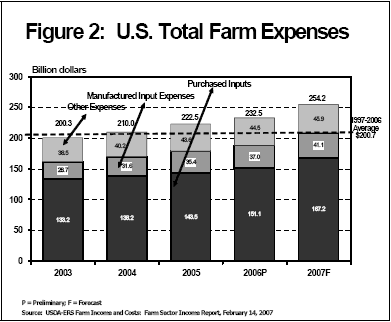AG-ECO NEWS
Vol. 23, Issue 35, December 4, 2007
Jose G. Peña
Extension Economist-Management
U.S. Net Farm Income Forecast Up $28.5 Billion
Production Costs Up $21.7 Billion
USDA’s November 29, 2007, estimate of U.S. net farm income for 2007 at $87.5 billion is up $20.9 billion (31%) from USDA’s initial estimate of $66.6 billion in February 2007 and up $28.5 billion (48%) from $59.0 billion in net income in 2006. If realized, net farm income in 2007 will be up $31.1 billion (52%) from a 10-year average of $57.4 billion and top the previous record of $85.9 billion in 2004. (See Figure 1)
While some producers lost some crops to excessive mid-summer rains in parts of Texas and the U.S. southeast region experienced a severe drought this past summer/fall, in general, 2007 is proving to be a very good year for U.S. producers, both crops and livestock. The boost in 2007 U.S. farm income is primarily the result of high commodity prices and improved yields. According to USDA-ERS Farm Income and Costs: 2007 Farm Sector Income Forecast report of November 29, 2007, the estimated values of crop and livestock production at $148.5 billion and $140 billion, respectively, are forecast to be a record high. Ethanol production is the single most significant activity affecting agricultural production. U.S. interest in renewable fuels has boomed in the last two years. Corn is the prime beneficiary of the increased production of biofuels, but soybeans are also used. Price bids for corn have almost doubled since last year and the outlook appears good as demand continues to increase.
Prices for a number of other major commodities have been higher throughout the year, and unexpectedly high for wheat, soybeans, and milk, among others. In addition, increased export demand for grains due to world reduced production as a result of extended droughts in competitor countries and increased international consumption is reducing world supplies and boosting grain prices. U.S. agricultural exports increased to a record high of $7.5 billion in August ‘07, one billion dollars above July ‘07 and $2.1 billion over August ‘06. This record level is due to huge exports of wheat, corn, and soybeans. With international growth in population and rising incomes, global wheat consumption has exceeded production in recent years. 
Production Costs Up
While the rise in commodity prices is boosting gross farm income, USDA-ERS November 29, 2007 forecast report indicates that U.S. production expenses in 2007 will exceed a 10-year average by $53.5 billion, partially offsetting the rise in gross farm income. (See Figure 2). The estimate of U.S. production costs for 2007 at $254.2 billion is up $21.7 billion (11%) from 2006 and up $30.9 billion (16%) from 2005, the year prior to the most recent increase in energy cost. This would indicate that agricultural production costs have increased an average of 16 percent since 2005. Meanwhile, direct government payments are expected to total $12.1 billion in 2007, down $1.5 billion from USDA’s initial estimate of $13.6 billion in February ‘07 and down $3.7 billion from the $15.8 billion paid out in 2006. This level would be 26 percent below the previous 5-year average and would indicate that even though commodity prices are high, the farm sector is carrying more risk, especially since Congress and the Administration have failed to pass a new farm bill.
Net farm income is the difference between gross farm income and production expenses. Consequently, net farm income in 2007 is forecast to be over $30 billion (52.6%) above its 10-year average of $57.4 billion.
Value of Crop Production
USDA-ERS’s November 29, 2007 report forecast the value of crop production to rise by over $30 billion in 2007 to $148.5 billion, the largest annual increase since 1984. Receipts from corn and soybeans—the top two crops are both expected to rise, with corn receipts reaching nearly $33 billion and soybeans $21 billion. Cash receipts for wheat and rice are expected to rise to all-time highs of $10 billion and $2 billion, respectively. Receipts for vegetables are expected to rise over $2 billion. Cash receipts for cotton and for fruits and nuts are expected to decline in 2007, with fruits and nuts slipping around $1 billion.
Value of Livestock Production
Despite the significant increase in livestock feed as prices for corn and other feed grains reach near record highs, USDA-ERS forecasts the value of livestock production in 2007 to rise to a record $140 billion. Cash receipts from all livestock species are forecast to exceed the $100-billion mark for the fifth consecutive year and the previous high by $15 billion.
Consumers Financing Energy Independence
While prices for grains have increased substantially, it appears clear that consumers are sharing the costs of this recent move towards energy independence. According to USDA-ERS , U.S. Farm Sector Overview report of October 31, 2007, in 2007, the Consumer Price Index (CPI) for all food is projected to increase 3.5 to 4.5 percent, as retailers pass on higher commodity and energy costs to consumers in the form of higher retail prices. Food-at-home prices are also forecast to increase 3.5 to 4.5 percent, while food-away-from-home prices are forecast to increase 3.0 to 4.0 percent in 2007. The all-food CPI increased 2.4 percent between 2005 and 2006.
